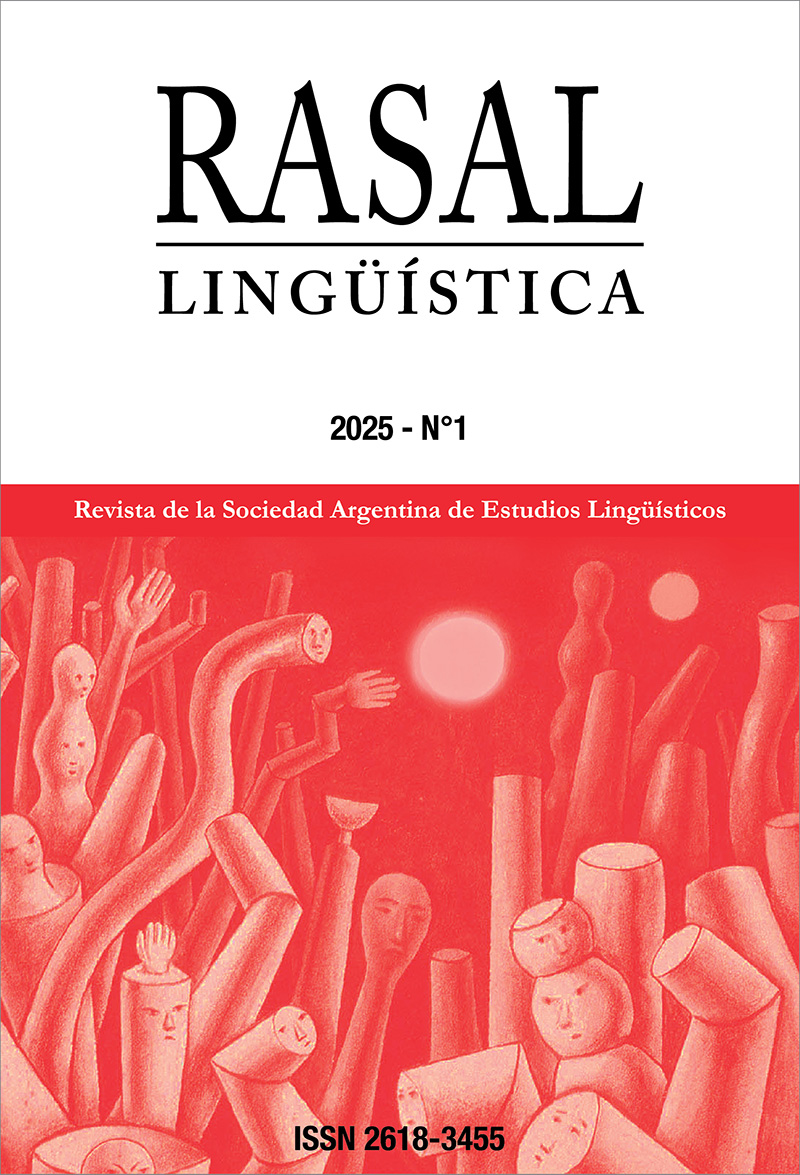Comparative study of diminutive expression resources in Qom and Pilaga (Guaycuruan)
DOI:
https://doi.org/10.56683/rs251156Keywords:
evaluative morphology, diminutive, Guaycuruan languages, Qom, PilagaAbstract
The aim of this paper is to study the diminutive category in the Pilaga language and varieties of Qom of the Guaycuruan language family of the Gran Chaco, based on unpublished data recorded by Salvador Bucca in the 1960s in communities of Formosa (1961 and 1964), Chaco (1963 and 1968), and Salta (1964 and 1978), as well as subsequent studies by other linguists covering the 1990s and the first two decades of the 2000s. The diminutive in these languages encompasses morphological and syntactic resources involving various word classes and includes a broad repertoire of meanings, ranging from size-related features to emotional affection. A comparative analysis is conducted on three types of diminutive expression found in both languages: specifically, the suffix -ole(k), which is added to nouns, personal pronouns, adjectives, and, exceptionally, to verbs and adverbs; the suffix/clitic -taeʔ / =tʔae, which occurs in noun phrases linked to the demonstrative; and the nominal compound with the inalienable term -qoʕot ~ -kʔoʕot ‘son’. It is observed that these three mechanisms have varying degrees of diffusion and productivity, and that some of them may be innovations of recent decades.
Downloads
References
Arcodia, G. (2015). Morfología evaluativa en Chinese. En N. Grandi. y L. Körtvélyessy (2015), Edinburgh Handbook of Evaluative Morphology (pp. 352-360). Edinburgh University Press.
Bauer, L. (1997). Evaluative morphology: in search of universals. Studies in Language, 21(3), 533–75.
Bruno L. y Najlis, E. (1965). Estudio comparativo de vocabularios tobas y pilagás. Centro de Estudios Lingüísticos – Universidad de Buenos Aires.
Bucca, S. Fondo Documental Bucca [Conjunto de datos]. Repositorio Digital Archivo DILA: http://www.caicyt-conicet.gov.ar/dila/collections/show/16
Buckwalter, A. (2001 [1980]). Vocabulario toba. Equipo Menonita/Mennonite Board of Missions [ed. revisada].
Carpio, M. (2012). Fonología y morfosintaxis de la lengua hablada por grupos tobas en el oeste de Formosa (Argentina). LINCOM.
Carrió, C. (2009). Mirada generativa a la lengua mocoví (Familia Guaycurú) [Tesis de Doctorado, Universidad Nacional de Córdoba].
Carrió, C. (2010). Los laberintos del tiempo y el hilo de Ariadna. La marcación de la temporalidad en la lengua mocoví (Familia guaycurú – Argentina). IEEE, 27, 237-267. https://doi.org/10.18441/ind.v27i0.237-267
Cúneo, P. (2014a). Augmentative in Toba (Guaycuruan): Form and Function. En S. Danielsen, K. Hanss y F. Zúñiga (2014), Word Formation in South American Languages (pp. 51-77). John Benjamins Publishing Company.
Cúneo, P. (2014b). Entre la dimensión física y la afectiva: forma y función del diminutivo en toba (guaycurú). UniverSOS – Revista de Lenguas Indígenas y Universos Culturales, 11, 121-138.
Cúneo, P. (2015). Morfología evaluativa en toba. En N. Grandi y L. Körtvélyessy (2015), Edinburgh Handbook of Evaluative Morphology (pp. 625-633). Edinburgh University Press.
Fabre, A. (2016). Gramática de la lengua nivacle (Familia Mataguaya, Chaco Paraguayo). LINCOM.
González, R. (2015). Estudio fonológico, morfológico y sintáctico del toba hablado en el este de la Provincia de Formosa (Argentina) desde el enfoque tipológico funcional. [Tesis de Doctorado, Universidad Nacional del Nordeste]. https://repositorio.unne.edu.ar/bitstream/handle/123456789/1067/RIUNNE_TD_Gonzalez_RE.pdf?sequence=1&isAllowed=y
Grandi, N. (2002). Morfologie in contatto: le costruzioni valutative nelle lingue del Mediterraneo. Franco Angeli.
Grandi, N. (2015a). The place of evaluation within morphology. En N. Grandi y L. Körtvélyessy (2015), Edinburgh Handbook of Evaluative Morphology (pp. 74-90). Edinburgh University Press.
Grandi, N. (2015b). Evaluative morphology and number/gender. En N. Grandi. y L. Körtvélyessy (2015), Edinburgh Handbook of Evaluative Morphology (pp. 91-107). Edinburgh University Press.
Grandi, N. y Körtvlyessy, L. (2015). Why evaluative morphology?. En N. Grandi y L. Körtvlyessy (Eds.), Edinburgh handbook of evaluative morphology, 148 (pp. 3-20). Edinburgh University Press.
Grondona, V. (1998). A Grammar of mocovi [Tesis de doctorado, Universidad de Pittsburgh].
Gualdieri, B. (1998). Mocovi (Guaicuru). Fonologia e morfosintaxe [Tesis de Doctorado, Universidade Estadual de Campinas].
INDEC (2022). INDEC: Instituto Nacional de Estadística y Censos. https://www.indec.gob.ar/ftp/cuadros/poblacion/censo2022_poblacion_indigena.pdf
Klein, H. (1973). A grammar of Argentine Toba: verbal and nominal morphology [Tesis de Doctorado – Columbia University].
Körtvélyessy, L. (2015). Evaluative morphology from a cross-linguistic perspective: Introduction to the descriptive chapters. En N. Grandi y L. Körtvélyessy (2015), Edinburgh Handbook of Evaluative Morphology (pp. 187-194). Edinburgh University Press.
Messineo, C. (2003). Lengua Toba (guaycurú). Aspectos gramaticales y discursivos. LINCOM.
Messineo, C. y Cúneo, P. (2010). Modos de clasificación nominal en toba (guaycurú) y maká (mataguaya): zoonimia y fitonimia. En C. Messineo, G. Scarpa y F. Tola (2010), Léxico y categorización etnobiológica en grupos indígenas del Gran Chaco (pp. 27-64). Ediciones UNLPam.
Mutz, K. (2015). Evaluative morphology in a diachronic perspective. En N. Grandi, L. Körtvélyessy (2015), Edinburgh Handbook of Evaluative Morphology, (pp. 142-154) Edinburgh University Press.
Najlis, E. (1966). Lengua abipona. Centro de Estudios Lingüísticos – Universidad de Buenos Aires.
Nercesian, V. (2015). Morfología evaluativa en wichí. En N. Grandi. y L. Körtvélyessy (2015), Edinburgh Handbook of Evaluative Morphology (pp. 625-633). Edinburgh University Press.
Payne, D. y Vidal, A. (2020). Pilagá determiners and demonstratives: Discourse use and grammaticalisation. En Å. Næss, A. Margetts y Y. Treis (2020), Demonstratives in discourse, (pp. 149-183). Language Science.
Sandalo, F. (1997). A grammar of Kadiweu with special reference to the Polysynthesys Parameter. Cambridge University Press.
Scalise, S. (1986). Generative Morphology. Foris – Studies in Generative Grammar.
Strump, G. (1993). How peculiar is evaluative morphology? Journal of Linguistics, XX, pp. 1-36.
Tacconi, T. (2018). Del léxico a la gramática: rutas de gramaticalización en maká. Káñina – Rev. Artes y Letras, XLII, 9-27.
Vidal, A. (1997). Noun classification in Pilaga. Journal of Amazonian Languages, XX, 58-111.
Vidal, A. (2001). A Grammar of Pilaga (Guaycuruan) [Tesis de Doctorado, University of Oregon].
Vidal A., Machuca, D. y Sánchez, M. (2022). Nos perdimos en el monte al regreso: los viajes del Dr. Salvador Bucca a Formosa en los años sesenta. Corpus, 12(1), pp. 1-21. https://journals.openedition.org/corpusarchivos/5692
Viegas Barros, P. (2013). Proto-Guaicurú. Una reconstrucción fonológica, léxica y morfológica. LINCOM.
Published
How to Cite
Issue
Section
License
Copyright (c) 2025 Mayra Julieta Sánchez

This work is licensed under a Creative Commons Attribution-NonCommercial 4.0 International License.
RASAL © Algunos derechos reservados










